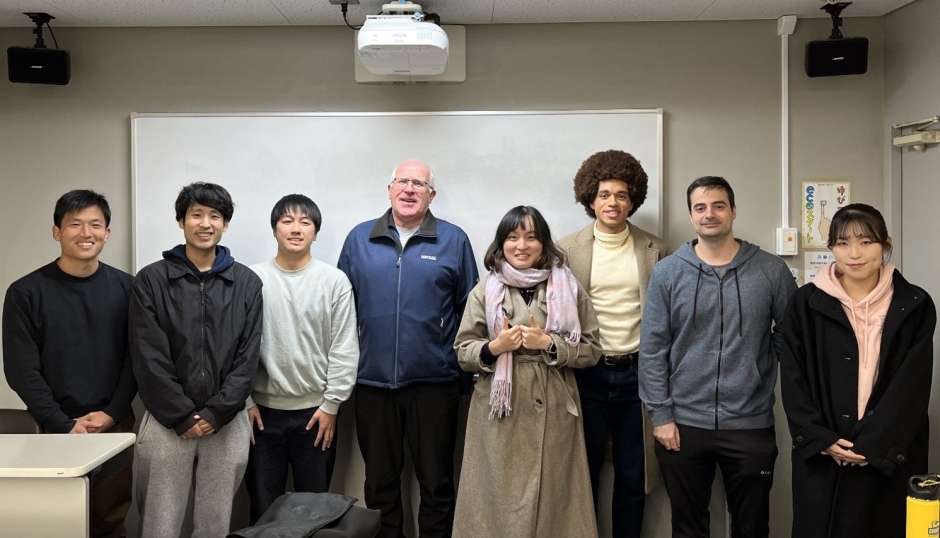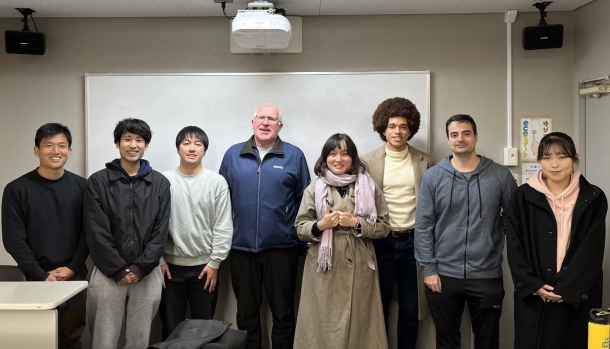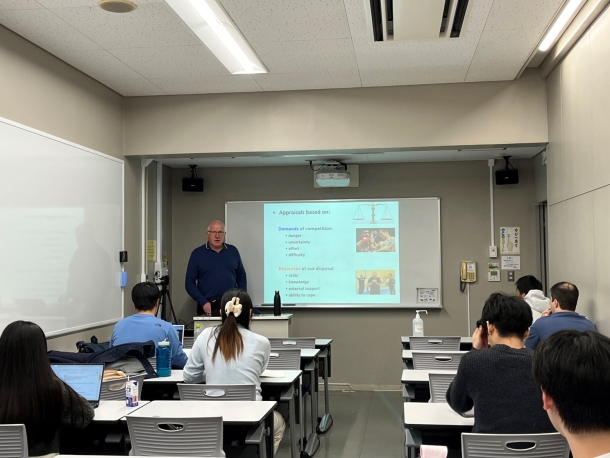- ニュース
- 早稲田大学健康スポーツ科学拠点では、2024年11月1日から12月1日まで、バーミンガム大学クリストファー・リング教授(Professor Christopher Ring)を招聘し、対面での秋学期集中講義(14回)を実施しました。
早稲田大学健康スポーツ科学拠点では、2024年11月1日から12月1日まで、バーミンガム大学クリストファー・リング教授(Professor Christopher Ring)を招聘し、対面での秋学期集中講義(14回)を実施しました。

- Posted
- 2024年12月13日(金)
クリストファー・リング教授は、バーミンガム大学スポーツ運動リハビリテーション科学部でスポーツ心理学を担当されています。精神生理学の研究手法を適用し、動作スキルの習得やプレッシャー下での「あがり」防止等、数多くの研究論文をこれまでに発表されています。
本学には2023年10月8日に開催されたSGU10周年記念シンポジウム「Play Sports, Stay Healthy, and Enjoy Aging Society – Our Global Collaborations, Achievements And Beyond」の招待講演で初めてお越しになりました。今回、スポーツ科学学術院を再訪され、集中講義「Psychophysiology of Sport, Exercise and Performance」をご担当いただきました。滞在中には、本学術院の正木宏明教授との共同研究を通して、大学院生への研究アドバイスも積極的に行っていただきました。
集中講義では以下のトピックスが扱われました。
Sport Performance: Classic Theories & Processing Efficiency Theory
Reinvestment Theory & Implicit Motor Learning
Sport Evoked & Induced EEG Responses, Sport Neurofeedback
Preparation for Action, Attentional Focus 他


以下は、本集中講義に参加した学生からのレポートです。
Class Report of Psychophysiology of Sport, Exercise and Performance |
| Yunfan Wu, Ph.D. 3rd year student |
|
This semester, I attended an intensive class taught by a visiting scholar. Professor Christopher Ring is a leading scholar in sport psychology. His class is held twice a week. In each class, he introduced a main topic, collected many studies to explain the concept, and shared the important findings with us. We can quickly grasp the basic picture of how to design the experiment using physiological indicators and what results they found. We will have a general idea about designing different experiments by measuring physiological indicators in sport psychology. The first class explores the link between anxiety, arousal, and sports performance, discussing models like social facilitation, the inverted-U hypothesis, and catastrophe theory. Physiological indicators such as EEG and heart rate variability highlight how stress affects performance under pressure. The second class explores reinvestment theory, noting that pressure leads to overthinking, impacting performance, especially in novices. Athletes with high reinvestment tendencies perform worse under pressure, as seen in golf studies. Learning strategies can adjust these tendencies and improve performance. Psychophysiological processes during motor preparation indicate performance outcomes, with internal focus benefiting novices and external focus aiding experts. EEG studies reveal distinct brain activity patterns in experienced athletes during motor tasks. Social contexts also influence psychological experiences; team competitions enhance performance through social support. The biopsychosocial model shows that challenge appraisals can boost performance while threat appraisals hinder it. Quiet Eye (QE) refers to the crucial final gaze before action, with longer fixation periods linked to better performance in sports. The type of attentional focus affects motor learning, with an external focus generally yielding superior outcomes. EEG greatly aids in studying brain activity related to motor control, and NFT provides real-time feedback to help athletes optimize their brain function. Exercise enhances cognitive abilities and reduces pain perception, with moderate aerobic exercise being the most effective. Models like the Central Governor Model explain exercise regulation and Brain Endurance Training combines mental and physical tasks to improve overall performance. In Conclusion, these courses highlight the interaction of physiological and psychological factors influencing athletes’ performance and cognitive function. The research underscores the complexity of optimizing athletic and cognitive outcomes by integrating findings on anxiety, reinvestment, motor preparation, competition, challenge and threat states, attentional focus, neurofeedback, and exercise’s broader impacts. Happy to attend this class, and I hope we can invite more visiting scholars and have more classes in the future. |
